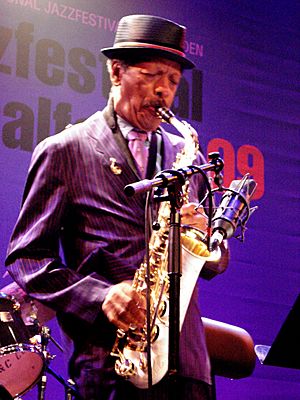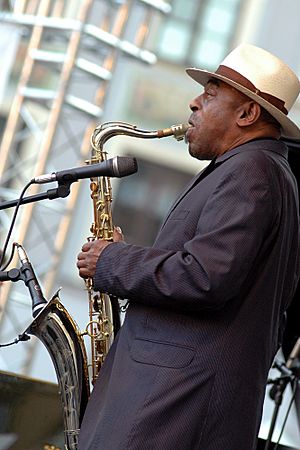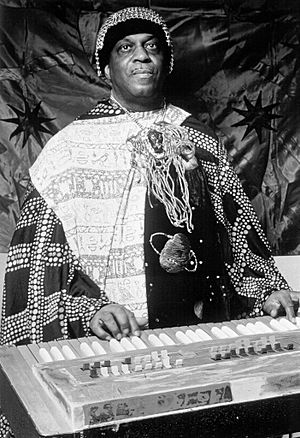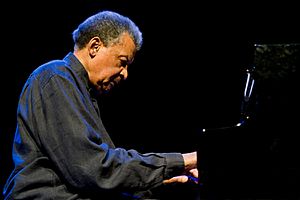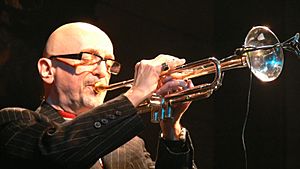Free jazz facts for kids
Quick facts for kids Free jazz |
|
|---|---|
| Stylistic origins |
|
| Cultural origins | late 1950s, United States |
| Derivative forms |
|
| Regional scenes | |
| Europe | |
| Other topics | |
|
|
Free jazz is a special kind of jazz music. It started in the late 1950s and early 1960s in the United States. Musicians wanted to try new things and break away from the usual rules of jazz. They changed things like regular tempos (speed), musical sounds, and chord changes (the way chords follow each other).
Many musicians felt that older jazz styles, like bebop, were too strict. They wanted to create something completely new and exciting. The name "free jazz" came from a famous 1960 album by Ornette Coleman called Free Jazz: A Collective Improvisation. In Europe, people often call it "free improvisation" instead. Some also call it "creative music" or "art music."
Free jazz can be a bit hard to explain because it's so open. It's usually played by small groups. But sometimes, even large big bands have played free jazz. While it seems very new, it also uses ideas from older jazz styles. It even takes inspiration from music around the world. Musicians might use instruments from Africa or Asia, or even invent their own. They focus on strong feelings and interesting sounds.
Contents
What Makes Free Jazz Unique?
Some jazz musicians don't like to put music into boxes. Most jazz has some improvisation (making music up on the spot). Free jazz uses many ideas from other jazz types. But it also has its own special features.
Breaking the Rules of Music
Older jazz often followed clear song structures. These included forms like the twelve-bar blues or 32-bar popular song forms. They had set chord changes. In free jazz, musicians don't have to follow these fixed forms. This means they can improvise much more freely.
Most jazz uses regular meters and steady rhythms. Think of a steady beat like 4/4 time. Free jazz still has a pulse, and sometimes it can even swing. But it doesn't always have a regular beat. The rhythm might speed up (wikt:accelerando) or slow down (ritardando). This makes the music feel like it's moving in waves.
Earlier jazz used specific harmonic structures. This means chords followed certain patterns. When musicians improvised, they used notes that fit those chords. Free jazz doesn't always follow these structures. But it's still jazz, so you can often hear familiar jazz sounds. You might hear diatonic (normal scale) or blues phrases.
New Ways to Play Instruments
Musicians like Pharoah Sanders and John Coltrane used special techniques. They would blow their instruments very hard. This created unusual sounds, like harsh overblowing. They explored new ways to make their instruments "speak."
In classical music, performers usually play exactly what the composer wrote. But in jazz, it's about the musician's own "voice" or "sound." Free jazz takes this even further. It's all about how the musician expresses themselves.
Music from Around the World
Some critics think that free jazz changed because musicians heard music from other cultures. They especially liked music from Africa, Arabia, and India. Free jazz often sounds "atonal," meaning it doesn't stick to a main key. Some historians say this is like going back to older American music. This includes field hollers (songs sung by workers) and street cries. This shows that free jazz wasn't just about new rules. It was also about connecting to older, deeper musical roots.
Free jazz became "free" by not depending on chord patterns. Instead, it used polytempic (many tempos) and polyrhythmic (many rhythms) ideas. Musicians also became interested in older jazz styles. They liked dixieland jazz, which had many musicians improvising together. They also loved African music.
This interest in world music led to using different instruments. Ed Blackwell played a West African talking drum. Leon Thomas used sounds like pygmy yodeling. Musicians also got ideas from experimental artists like John Cage.
Some people first thought free jazz musicians weren't skilled. But by the 1970s, most critics understood that free jazz was a serious art form.
Free Jazz and Freedom
Many people connect free jazz to the social changes in America. This was during the late 1950s and 1960s. It was a time when people were fighting for more freedom and equality. The word "free" in "free jazz" had a special meaning. It showed how musicians were breaking free from old musical rules. It also reflected the desire for freedom in society. Many see free jazz as a musical way to express the experiences of black Americans and their fight for freedom.
The History of Free Jazz
Free jazz really took off in the late 1950s. But some earlier music had similar ideas. For example, Lennie Tristano made recordings in the late 1940s. These included "Intuition" and "Digression." They used group improvisation without clear chord changes.
Early Pioneers
Ornette Coleman was a key figure. He didn't use pre-written chord changes. He believed that improvised melodies should create the harmony. His early albums like Tomorrow Is the Question! (1958) were different. They didn't follow typical song forms. They often had sudden changes in speed and mood.
Coleman's move to New York City really boosted free jazz. His albums The Shape of Jazz to Come and Change of the Century were very new. He started exploring music without a main key. His most important recording was Free Jazz (1960). This album was a big change. It had two quartets playing together, creating a powerful, sometimes noisy sound. The album's title gave the whole movement its name.
Pianist Cecil Taylor also explored free jazz. He was trained in classical music. His early albums showed ties to traditional jazz but with more complex harmonies. By the early 1960s, he moved fully into free jazz. He worked with saxophonist Jimmy Lyons and drummer Sunny Murray. They encouraged him to use new sounds like "tone clusters" (many notes played at once). Taylor's music often had no written scores or traditional jazz beats. He even used "prepared pianos," where objects are placed on the strings to change the sound.
Albert Ayler was another important artist. He started playing bebop saxophone in Scandinavia. He pushed jazz to its limits. He worked with Cecil Taylor in 1962. Ayler's music often sounded very different from past jazz. He focused on making unusual sounds with his saxophone. He created squawks and honks to get "multiphonic" effects (playing more than one note at once). Yet, Ayler also loved simple, folk-like melodies. He would explore these melodies in his wild, experimental style.
One of Ayler's famous recordings is Spiritual Unity. It includes his well-known song, Ghosts. This song starts with a simple, spiritual-like melody. Then, Ayler changes and twists it with his unique improvisation. Ayler showed that free jazz could be both experimental and connected to older music.
In 1963, John Coltrane said he learned from Ornette Coleman. Coltrane wanted to explore new forms and structures. His album A Love Supreme showed this. But his music was still closer to modal jazz and post-bop. Then, in 1965, he recorded Ascension. This album showed his interest in the new free jazz style. Coltrane added six more horn players to his band, including Archie Shepp and Pharoah Sanders. The song had free solo parts mixed with group improvisation, like Coleman's Free Jazz. Coltrane used techniques like over-blowing to create many sounds at once. He continued to explore experimental music in albums like Om and Meditations.
Much of Sun Ra's music from the 1960s can be called free jazz. Sun Ra said his music was written, but it sounded very free. His album The Heliocentric Worlds of Sun Ra (1965) was very unique. Sun Ra was a key voice in new jazz styles. His early work was more typical bebop. But he soon mixed atonal improvisation with Latin rhythms. His true free jazz experiments began in 1965. He focused on the sound and texture of music, not just rhythm or harmony. He used many electronic instruments and unusual percussion instruments. These included the electric celeste, Hammond B-3 organ, and timpani. Sun Ra was one of the first jazz musicians to use electronic sounds.
Charles Mingus also contributed to free jazz. His song "Pithecanthropus Erectus" had an improvised part that didn't follow the main melody. He helped bring back collective improvisation. This was important because many jazz bands at the time focused on solo players.
Free Jazz Around the World
Outside of New York, free jazz scenes grew in other cities. In Chicago, many artists joined the Association for the Advancement of Creative Musicians (AACM) in 1965. In St. Louis, the Black Artists Group was active. In Los Angeles, Horace Tapscott founded the Pan Afrikan Peoples Arkestra. Cleveland also had many free jazz musicians.
By the 1970s, New York City became a hub for experimental jazz. This led to "loft jazz." Musicians played in private homes and other unusual places. Free jazz started to mix with other styles, like pop music and world music. It no longer always meant completely rejecting melody or harmony. Instead, the free jazz of the 1960s became one of many influences for musicians.
Some musicians today mix free jazz with more traditional sounds. They might start with a familiar tune. Then they play a completely free part. Finally, they return to the recognizable tune. This gives listeners something to hold onto while still enjoying the freedom. Musicians like Miles Davis, Cecil Taylor, John Klemmer, Keith Jarrett, Chick Corea, Pharoah Sanders, McCoy Tyner, Alice Coltrane, Wayne Shorter, Anthony Braxton, Don Cherry, and Sun Ra have used this approach.
Free Jazz Around the World
In Canada, the Quatuor de Jazz Libre du Québec was a notable early free jazz group. Free jazz also became popular in Europe and Japan. Famous early European free jazz players include saxophonists Peter Brötzmann and Evan Parker. There were also trombonist Conny Bauer and guitarist Derek Bailey. European free jazz often moved towards "free improvisation." This meant it had less connection to traditional jazz.
Japan's first free jazz musicians included drummer Masahiko Togashi and guitarist Masayuki Takayanagi. In countries behind the iron curtain, musicians like Janusz Muniak and Tomasz Stańko played free jazz. Some international jazz musicians came to North America and joined the free jazz scene. These included Ivo Perelman from Brazil and Gato Barbieri from Argentina.
South African artists like Dollar Brand and Chris McGregor also experimented with free jazz. They mixed experimental improvisation with African rhythms and melodies. American musicians like Don Cherry and John Coltrane added elements from the music of Africa, India, and the Middle East. This created a "world music"-influenced free jazz.
|
See also
 In Spanish: Free jazz para niños
In Spanish: Free jazz para niños



